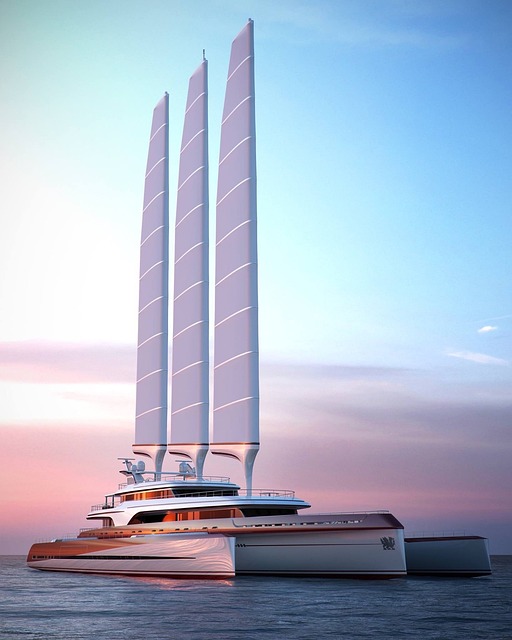Optimizing Your Catch: Selecting the Ideal Boat Battery for Fishing Excursions
When choosing a boat battery for your fishing excursions, prioritize a model that meets the specific energy demands of your trip, considering factors such as capacity (measured in ampere-hours), Cold Cranking Amps (CCA) for cold weather performance, reserve capacity for extended power supply, and p…….

When choosing a boat battery for your fishing excursions, prioritize a model that meets the specific energy demands of your trip, considering factors such as capacity (measured in ampere-hours), Cold Cranking Amps (CCA) for cold weather performance, reserve capacity for extended power supply, and physical dimensions to fit your boat without excessive weight. Opt for modern battery types like AGM or GEL batteries for their maintenance-free, spill-proof, and stable nature during boat motion. For high-performance fishing applications, lithium-ion batteries with a Battery Management System (BMS) are a top choice due to their superior power density and longevity. Regular maintenance, including cleaning terminals, checking water levels for lead-acid batteries, and using smart chargers, will ensure your battery operates efficiently and has a long service life. Always select a battery with a capacity and reserve capacity that aligns with your fishing setup's needs, ensuring you have reliable power for starting the engine, electronics, and other essential devices throughout your fishing trip. Adhering to these guidelines will help you select an optimal boat battery that enhances your fishing experience and ensures your equipment operates efficiently and reliably.
Embarking on a fishing expedition requires careful selection of a boat battery that suits your angling adventures. This article navigates through the critical aspects of choosing the optimal marine power source, from understanding the diverse types of boat batteries to their specific roles in enhancing your fishing trip. Key specifications, tailored to fishing needs, are deciphered to guide you in making an informed decision. Additionally, practical tips on preserving and prolonging your battery’s lifespan are provided. Whether you’re after a deep-cycle battery for trolling or an AGM model for those long days on the water, the top recommendations for high-performance fishing boat batteries on the market are outlined to ensure your next catch is powered by the best.
- Understanding Boat Battery Types and Their Roles in Fishing Trips
- Key Specifications to Consider When Selecting a Boat Battery for Fishing
- Assessing Your Fishing Needs and Matching Them with the Right Boat Battery
- Tips on Maintaining and Maximizing the Life of Your Fishing Boat Battery
- Top Recommendations for High-Performance Fishing Boat Batteries on the Market
Understanding Boat Battery Types and Their Roles in Fishing Trips

When planning for a fishing trip, selecting the right boat battery is crucial for ensuring your journey is both enjoyable and successful. There are several types of boat batteries available on the market, each designed to cater to different needs based on the demands of your fishing excursions. The first category to consider is the starting battery, also known as a cranking battery. This type of battery delivers a high burst of current needed to start your boat’s engine. It’s essential that this battery is in optimal condition since it’s responsible for the initial power demand when you turn the ignition key.
Once your vessel’s engine is running, the secondary battery, often referred to as a deep-cycle battery, takes over. This battery type is specifically designed to handle frequent discharges and recharges without compromising performance or lifespan. For fishing enthusiasts, this means having reliable power for trolling electronics, fish finders, GPS systems, and other onboard accessories throughout the trip. When choosing a deep-cycle battery, consider factors such as the battery’s capacity, reserve capacity, and amp-hour rating to ensure it aligns with your specific power requirements. Understanding the roles of these two types of batteries is key to selecting the best boat battery for your fishing trips, ensuring that every aspect of your adventure on the water is powered without interruption.
Key Specifications to Consider When Selecting a Boat Battery for Fishing

When selecting a boat battery tailored for fishing excursions, it’s crucial to consider several key specifications that will ensure your equipment operates efficiently and reliably on the water. The first consideration is the type of battery most suitable for your application. Lead-acid batteries have been traditional choices, offering robust performance, but they are heavier and require regular maintenance. Alternatively, modern AGM (Absorbent Glass Mat) or GEL batteries are spill-proof, maintenance-free, and more resilient to the rocking motion of a boat, making them excellent choices for marine use.
Another vital specification is the battery’s capacity, measured in ampere-hours (Ah). This determines how much energy the battery can store and deliver over a specific time period. For fishing trips, a higher Ah rating will provide more power for longer periods, which is essential for running electronics like fish finders, GPS units, and trolling motor batteries. Additionally, consider the Cold Cranking Amps (CCA) if you fish in colder climates to ensure the battery maintains its performance when temperatures drop. Furthermore, the physical dimensions and weight of the battery must be compatible with your boat’s available space and carrying capacity. Lastly, the reserve capacity (RC) is a measure of how many minutes the battery can deliver a nominal current at 25 amperes before running down to 10.5 volts, which can be particularly useful during those extended fishing sessions where power conservation is key. By carefully evaluating these specifications, you’ll be better equipped to choose the best boat battery for your next angling adventure.
Assessing Your Fishing Needs and Matching Them with the Right Boat Battery

When selecting a boat battery for your fishing excursions, it’s crucial to consider the specific demands of your outings. Your fishing needs will dictate the type and size of the battery that best suits your vessel. For instance, if you frequently venture into remote waters where you’ll rely on trolling or live bait setups for extended periods, a high-capacity marine battery with a reliable cranking amp (CA) and reserve capacity (RC) will be essential. These batteries are designed to deliver consistent power for longer durations, ensuring your electronics, lighting, and other electrical equipment function optimally throughout the day. On the other hand, if your fishing trips are shorter and involve primarily quick-strike setups with minimal power draw, a smaller, lighter starting battery might be all you need. Regardless of your requirements, the key is to match the battery’s capacity with the power consumption of your onboard devices. This balance will maximize performance and efficiency while minimizing weight, which is always a consideration for boat owners. Additionally, consider the type of fishing you engage in; offshore or deep-sea fishing may demand robust batteries with high ampere-hour (AH) ratings due to the longer distances from the shore and the need for additional power for running down larger fish. Freshwater bass fishing, by comparison, might require less intense battery performance, allowing for a more cost-effective option that still meets your needs without unnecessary overkill. In any case, durability, cold cranking amps (CCA), and the ability to withstand harsh marine conditions are paramount when choosing the best boat battery for your fishing endeavors. Always select a battery that aligns with your fishing style and the electrical load of your boat to ensure a reliable and uninterrupted experience on the water.
Tips on Maintaining and Maximizing the Life of Your Fishing Boat Battery

When it comes to maintaining and maximizing the life of your fishing boat battery, there are several key practices to consider for optimal performance. Regularly inspecting the battery terminals and connections is paramount; ensure they are clean, tight, and free from corrosion. This maintenance step not only prevents poor electrical contact but also helps to prevent battery strain that could lead to a shorter lifespan. Additionally, keeping an eye on the water level in lead-acid batteries, if equipped, is crucial. Distilled water should be added as necessary to maintain the proper electrolyte concentration, which in turn supports consistent chemical reactions within the battery and ensures a steady energy supply for your fishing trips.
Furthermore, it’s important to practice smart charging habits. Overcharging can severely diminish the battery’s capacity and potentially cause irreversible damage. Investing in a quality charger with a maintenance mode that automatically adjusts the charge based on the battery’s state of charge can greatly enhance its longevity. Also, storing your boat battery in a cool, dry place when not in use and always recharging it fully after each trip will help to preserve its charge capacity and prevent sulfation, a common issue that reduces battery efficiency over time. Regularly running a full discharge followed by a complete recharge cycle within the boat’s electrical system can also be beneficial for lead-acid batteries, as it helps to maintain the plasma electrolyte’s distribution. By adhering to these maintenance practices, you can ensure that your fishing boat battery delivers reliable power for countless outings on the water.
Top Recommendations for High-Performance Fishing Boat Batteries on the Market

When venturing out on the water for a day of fishing, having a reliable boat battery is paramount to ensure your journey is both safe and enjoyable. The best boat batteries for high-performance fishing applications are those that offer consistent power output, long service life, and resistance to the harsh marine environment. Among the top recommendations for high-performance fishing boat batteries on the market, AGM (Absorbed Glass Mat) and lithium-ion options stand out due to their durability and reliability. The AGM battery, known for its spill-proof nature and ability to withstand vibrations commonly found in a boat’s engine compartment, is a favorite among seasoned anglers. It provides a balanced charge and discharge profile, which means your trolling motors and electronics will function optimally throughout the day.
Lithium-ion batteries, on the other hand, offer even greater power-to-weight ratios, making them an excellent choice for those looking to maximize their boat’s performance without adding unnecessary bulk. They also have a higher cycle life compared to traditional lead-acid batteries, which translates to fewer replacements over the lifespan of your fishing setup. When selecting a lithium battery, consider models with built-in battery management systems (BMS) to protect against overcharging and ensure longevity. Both AGM and lithium-ion options should be evaluated based on their cold cranking amps (CCA), reserve capacity (RC), and depth of discharge (DOD) to match the specific needs of your fishing boat and intended usage patterns. Always refer to the manufacturer’s guidelines for optimal performance and safety.
When selecting a boat battery tailored for fishing excursions, it’s crucial to consider factors such as capacity, type, and maintenance requirements. Your fishing needs dictate the ideal battery choice, be it for trolling or longer expeditions. By referencing top recommendations for high-performance fishing boat batteries available today and adhering to maintenance tips that maximize lifespan, anglers can ensure their vessel is powered by a reliable source of energy, ready to navigate the best fishing spots. With the insights provided, you’re well-equipped to choose the best boat battery for your next angling adventure.







